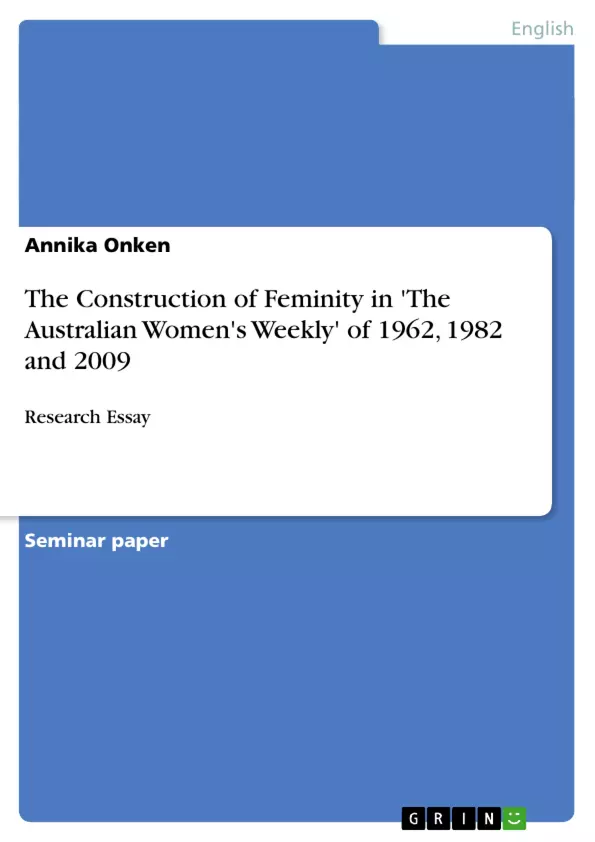The first edition of the magazine 'The Australian Women’s Weekly' was published in 1933 and continues its publications till today. Therefore the magazine offers a long history of being, also advertising, medium for ideas, opinions and reflections about feminity. The subject matter and advertisement the magazine addresses its readers with constitutes the fields of interest those women might be attracted towards. At the same time it excludes certain fields of female interest.
In this research essay I will examine how feminity is constructed in 'The Australian Women’s Weekly' from three different time periods by having a closer look at the fields of ‘The Domestic Sphere’, ‘Beauty and the Body’, and ‘Progression of the Self’. I will have a look at the construction of the domestic sphere portrayed as being an inherent responsibility and centre of female existence. Are broader political and social topics addressed; and in what way? How is women’s position in society understood? Furthermore, I will ask how the depicted ideal feminity is linked to body looks and sexuality. In a third step I will examine the emphasis put on inspiration as being an integral part of feminity. What functions are served by the printing of celebrity life stories, the responses of ‘agony aunts’ and romantic fiction?
The investigation of editions from 1962, 1982 and 2009 will focus on whether and how ideologies of feminity have changed during the decades and if there can be detected certain recurring ideological fragments. Does the representation of maternity and Australianess evolve during the decades? In what way do these magazines adjust to changing reader’s needs? Which female ideologies are we facing today?
Inhaltsverzeichnis (Table of Contents)
- INTRODUCTION
- THE AUSTRALIAN WOMEN'S WEEKLY 1962
- THE DOMESTIC SPHERE
- BEAUTY AND THE BODY
- PROGRESSION OF THE SELF
- THE AUSTRALIAN WOMEN'S WEEKLY 1982
- THE DOMESTIC SPHERE
- BEAUTY AND THE BODY
- PROGRESSION OF THE SELF
- THE AUSTRALIAN WOMEN'S WEEKLY 2009
- THE DOMESTIC SPHERE
- BEAUTY AND THE BODY
- PROGRESSION OF THE SELF
- CONCLUSION
Zielsetzung und Themenschwerpunkte (Objectives and Key Themes)
This research essay aims to examine how feminity is constructed in The Australian Women's Weekly across three different time periods (1962, 1982, and 2009) by analyzing the representations of "The Domestic Sphere", "Beauty and the Body", and "Progression of the Self".- The portrayal of the domestic sphere as an inherent responsibility and the center of female existence.
- The connection between idealized femininity and body image and sexuality.
- The emphasis on inspiration as an integral part of feminity and the functions served by celebrity life stories, agony aunts, and romantic fiction.
- The evolution of ideologies of femininity over time and the identification of recurring ideological fragments.
- The representation of maternity and Australianess across the decades and the adaptation of the magazine to changing reader needs.
Zusammenfassung der Kapitel (Chapter Summaries)
The 1962 edition of The Australian Women's Weekly appears to support the idea that women's magazines emphasize the ideology of family, maternity, and domesticity. Advertisements focus on domestic commodities and encourage women to embrace their roles as wives, mothers, and consumers. However, the magazine also presents women as travelers, active members of society, and financially independent. It highlights female achievements in various fields while avoiding social or political problems like the Vietnam War. Women are shown as aware of societal expectations while displaying a degree of rebelliousness regarding their roles. The 1962 edition focuses on beauty ideals through advertisements for hairspray and cosmetics, emphasizing a "natural" beauty enhanced through products and a "feline" and "madly mysterious" look inspired by Cleopatra. The magazine presents female beauty as a combination of looks and business skills, reflecting Hollywood's influence on beauty standards. It also promotes a healthy, comfortable, and romantic image, emphasizing quality and easy maintenance. However, the magazine also depicts men-serving beauty ideals through products like girdles and weight-loss treatments, and emphasizes foreign fashion trends.- Citar trabajo
- Annika Onken (Autor), 2009, The Construction of Feminity in 'The Australian Women's Weekly' of 1962, 1982 and 2009, Múnich, GRIN Verlag, https://www.grin.com/document/137793



